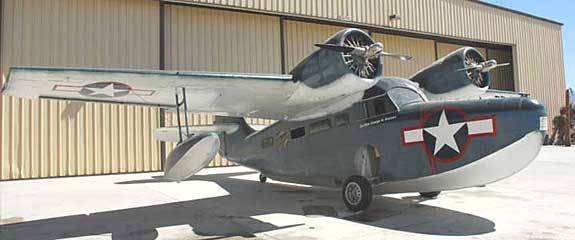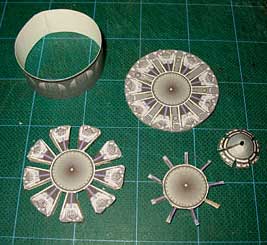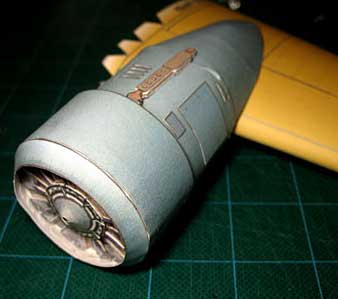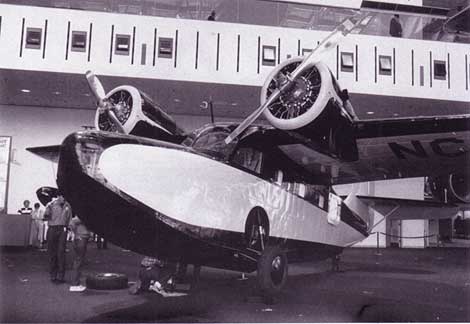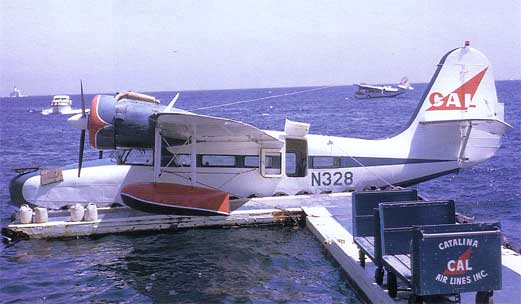



Grumman Goose Amphibious (G-21) Aircraft
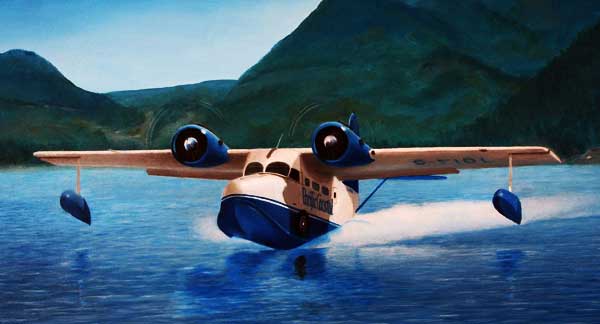
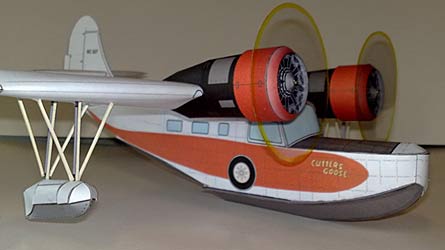 Affectionately nicknamed 'Grumman Goose'.
the G-21 was Grumman's first monoplane to fly, its first twin
engine aircraft, and its first aircraft to enter commercial airline
service. This remarkably
versatile amphibian has served for over fifty
years in a variety of roles that have confirmed the strength and
durability of its original design.
Affectionately nicknamed 'Grumman Goose'.
the G-21 was Grumman's first monoplane to fly, its first twin
engine aircraft, and its first aircraft to enter commercial airline
service. This remarkably
versatile amphibian has served for over fifty
years in a variety of roles that have confirmed the strength and
durability of its original design.
The inspiration for the G-21 came from a syndicate
of ten wealthy New York businessmen and aviators led by Wilton
Lloyd-Smith who were seeking a replacement for the Loening Air
Yacht that they used to commute from their Long Inland homes to their
offices in Manhattan.
I'm looking forward to the Grumman Goose. I used to fly to Catalina Island every summer and learned, that if you were the last in line, you got to sit in the co-pilot's seat. The pilot would let you wind the crank to retract the landing gear....about 60 cranks!! Best regards, Tim McCannon
I have just seen the page on the Grumman Goose what an outstanding model! I’m an avid RC-waterflier and after the success with the FG DC-3 flying conversion I`d be happy to add a micro Flying boat to my fleet :) When will the plans for the Goose come out ? Any chance to get a beta file to see how it`s going to work in foam ? I`d really like to see a few more flying boats from FG, for example a CL-215 or maybe some of the WW2 types that have not been modeled so often (PB2Y Coronado maybe?)
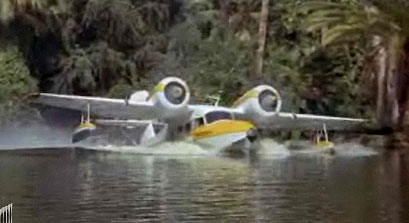 |
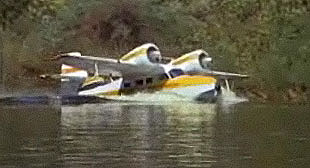 |
| Here are three views of the Grumman Goose that was used on the TV series, 'Fantasy Island'. Modeln' Pal Joe Golden pulled them off the video. In the photo to the right you can see a chap working with some cargo in the forward hatch. Coping with cargo so far forward says much about this Gooses' inherent stability. | 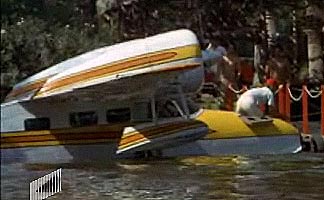 |
Grumman G-21 "Goose"
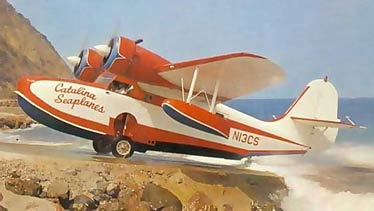 In 1935 they approached Grover Loening, who declined but suggested
that the syndicate contact the Grumman Aircraft Engineering Corporation,
for which Loening consulted and which he had helped finance. Leroy Grumman
accepted and immediately went to work with designer and company
co-founder William Schwendler. as well as hydrodynamicist Ralston
Stab to build the new G-21 amphibian air yacht.
In 1935 they approached Grover Loening, who declined but suggested
that the syndicate contact the Grumman Aircraft Engineering Corporation,
for which Loening consulted and which he had helped finance. Leroy Grumman
accepted and immediately went to work with designer and company
co-founder William Schwendler. as well as hydrodynamicist Ralston
Stab to build the new G-21 amphibian air yacht.
The outline of the new design emerged quickly, revealing a stubby yet graceful aircraft constructed of 24ST Alclad aluminum, the 0-21 was an all metal, high-winged monoplane powered by two 450 horsepower Pratt & Whitney Wasp Jr. nine cylinder, air-cooled radial engines mounted on the leading edge of the high set wings. The deep fuselage served also as a hull and was equipped with hand-cranked retractable landing gear. Inside the cabin was room for four to six passengers and a flight crew of two. Depending on the level of comfort desired by the individual customer, the G-21 could be fitted with a galley and a lavatory. Floats were suspended beneath each wing and a conventional cruciform tail section installed. Misspellings: Amfibios AMPHIBOUS .
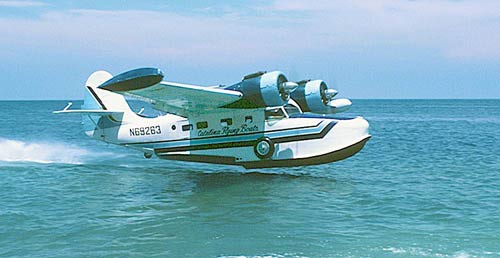 On
May 29, 1937, the G-21 completed its first test flight, piloted
by Robert L Hall and Bud Gillies from Grumman's Bethpage, New
York factory. Flight trials went smoothly and after a lengthening
of the hull step to improve the aircraft's performance on the
water, the aircraft was readied for production.
On
May 29, 1937, the G-21 completed its first test flight, piloted
by Robert L Hall and Bud Gillies from Grumman's Bethpage, New
York factory. Flight trials went smoothly and after a lengthening
of the hull step to improve the aircraft's performance on the
water, the aircraft was readied for production.
The performance of the G-21 was praiseworthy for its time and rivaled commercial airliners in service. With a cruising speed of 150 miles per hour, the G-21 had a range of 500 miles. (One of the versions included in the Grumman Goose folder features Catalina Island markings shown above).
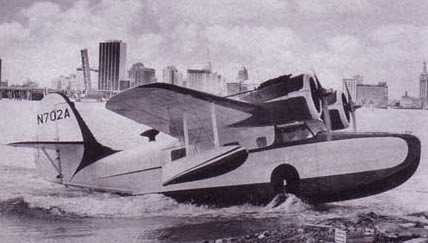 On July 3, just five weeks after its maiden flight, the first
of twelve G-21s ordered was delivered to its initial customers.
Wilton Lloyd-Smith and department store hair Marshall Field III.
Soon other wealthy owners were enjoying the exemplary flight characteristics
and handling of the G-21 Goose. Among those customers were financiers
Henry H. Morgan and E. Roland Harriman, C. W. Deeds of United
Aircraft, Colonel McCormick of the Chicago 5-bunch, Boris Sergievsky,
test pilot for Sikorsky Aircraft, and Britain's
Lord Beaver brook. In addition, two were purchased by Asiatic Petroleum.
Soon these aircraft were modified to G-21A standards with Wasp
Jr. SB-2 engines, an increase in certificated gross weight from
7,500 to 8,000 pounds, and a slightly modified hull to reduce
water spray.
On July 3, just five weeks after its maiden flight, the first
of twelve G-21s ordered was delivered to its initial customers.
Wilton Lloyd-Smith and department store hair Marshall Field III.
Soon other wealthy owners were enjoying the exemplary flight characteristics
and handling of the G-21 Goose. Among those customers were financiers
Henry H. Morgan and E. Roland Harriman, C. W. Deeds of United
Aircraft, Colonel McCormick of the Chicago 5-bunch, Boris Sergievsky,
test pilot for Sikorsky Aircraft, and Britain's
Lord Beaver brook. In addition, two were purchased by Asiatic Petroleum.
Soon these aircraft were modified to G-21A standards with Wasp
Jr. SB-2 engines, an increase in certificated gross weight from
7,500 to 8,000 pounds, and a slightly modified hull to reduce
water spray.
The popularity of the G-21 spread as its versatility became well-known
throughout the aviation community. Soon orders came in to Grumman
from airlines, the military, and foreign customers, impressed
by the G-21's potential. Lloyd Aero Boliviano (LAB) was the first
airline to purchase the G-21 but did not put it into service.
KNILM, the Dutch East Indies subsidiary of KLM, acquired two G-21's
and operated them from 1940 until early 1942 when the last one
was shot down by the invading Japanese. The coming of World War
II prevented the adoption of the Goose on a wider scale by airlines
until after the cessation of hostilities.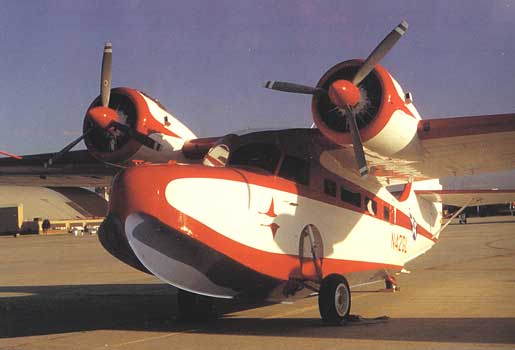
In 1938, the Royal Canadian Air Force was the first military service
to recognize the abilities of the Goose when it ordered one in
June of that year, followed soon by orders from the U.S. Army
and Navy, as well as the Peruvian Air Force and the Portuguese
Navy. During World War II, the Army was the first to order a substantial
quantity, operating 26 as OA-9s and OA-13s. The U.S. Navy and
Coast Guard operated 169 "Gooses" designated as JRFs
in utility, transport, and antisubmarine duty. In total, the air
forces and navies of eleven nations have flown the Goose. France
flew at least fifteen in combat in Indochina where several JRFs
were armed with bombs and machine guns.
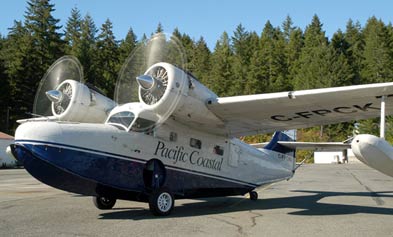 A total of 345 G-21 s were produced by October 1945 when production
ended. While most of the G-21 s were quickly phased out of military
service after World War II, the Goose renewed its career as an
airliner in earnest. Uniquely adapted for travel in virtually
any environment, the Goose saw widespread service with small airlines in the Caribbean, California, and Alaska. Among
those flying the G-21 were Reeve Aleutian Airways, Alaska Coastal
Airlines, Chalk's Flying Service, and Mackey Airlines.
A total of 345 G-21 s were produced by October 1945 when production
ended. While most of the G-21 s were quickly phased out of military
service after World War II, the Goose renewed its career as an
airliner in earnest. Uniquely adapted for travel in virtually
any environment, the Goose saw widespread service with small airlines in the Caribbean, California, and Alaska. Among
those flying the G-21 were Reeve Aleutian Airways, Alaska Coastal
Airlines, Chalk's Flying Service, and Mackey Airlines.
Antilles Air Boats was particularly noted for flying the Goose around the Caribbean from their base in St. Croix in the Virgin Islands. Avalon Air Transport (later Catalina Airlines) competed for a while with Catalina Seaplanes, connecting southern California with Catalina Island.
The US Navy just loved the Grumman Goose:
One of the most desirable of antique airplanes is the Grumman
Goose. With amphibious capability, a tail dragger landing
gear configuration, and two Pratt & Whitney 450 hp engines,
the Goose can go almost anywhere. It is not fast, but the airplane
can carry eight people, and do it with style!!
The airplane was used during the War by the U.S. Army Air Force, the U.S. Navy, and the U.S. Coast Guard as a coastal patrol airplane, a training tool, and as an air-sea rescue machine. After the War, they were quickly snapped up as surplus airplanes to go into service with the civilian Goose as airline airplanes and executive transports for the sporting type of executive.
The G-21 Grumman Goose proved a remarkably successful airplane that appealed to civil and military operators alike for its amphibious capability, capacious fuselage and modest fuel requirements. The version taken by the US Navy was designated JRF, and this was developed in variants up to the JRF-5 with cameras for photo-survey, and the JRF-6B Lend Lease model intended for air/sea rescue and navigation training. A number of these essentially similar models were delivered to France after World War II for use in the coastal reconnaissance and air/sea rescue roles, proving invaluable as the French authorities redrew their coastal charts to take account of World War II wrecks and other features. (the version shown above is not included in the folder) |
The 'Step':
Most flying boats and floatplane's have a 'step'.. which is a break
in the bottom of the plane that helps separate the hull of the
plane from the water. On our Grumman Goose, notice
the rows of holes, which help prevent the creation of a vacuum
between the plane and the water. Taking off from the water has
two distinct stages, which consist of picking up enough speed
to lift out of the water and "ride the step," and then
picking up more speed for the wings' lift to literally
pull the rest of the plane out of the water. The Goose takes off
and lands at a speed somewhere around 60 mph.
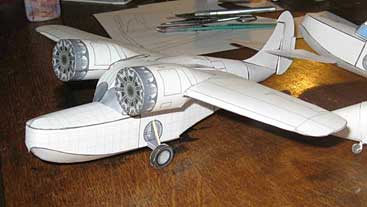 Dr. Glen Volyn, FG designer, sent in this photo of a very early beta Grumman Goose proofing. Notice several other betas in the background' |
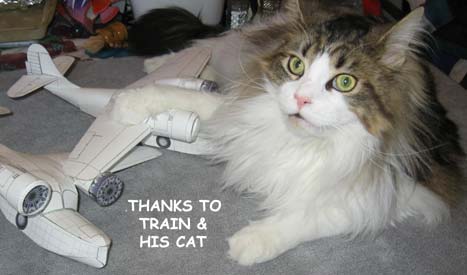 Thanks for giving me the opportunity to Beta
build the Goose. This is my first Beta assembly. Please
notice the build of version #1 is missing one wing float.
The reason is the inquisitive and playful furry creature
we call Moose. When and if I find the part, I will attach
it. On track this time, YMP Trains Thanks for giving me the opportunity to Beta
build the Goose. This is my first Beta assembly. Please
notice the build of version #1 is missing one wing float.
The reason is the inquisitive and playful furry creature
we call Moose. When and if I find the part, I will attach
it. On track this time, YMP Trains |
1 - Printed 3 copies of the engine 2 - Mounted on thick board (artist illustration board) 3 - Trimmed out one full engine plate, one with just the center and the cylinders, and one with just the center and the purple wires. 4 - Glued on top of each other, capped of with the little dome-thing. For the raised exhaust pipe I mounted a copy to the thick board and trimmed out, glued in place over the straight- printed one. I also printed additional pieces so I could layer the little access doors and panels. Layering pieces is the absolutely easiest and quickest way to add detail and depth to any model. It works great, simple to do, but looks like a million bucks! Even if the layered piece doesn't jump out, the little side shadows the cast add a lot. My first use was on the V-300 Early Helicopter. I layered a single piece around the pilots compartment. Doesn't jump out, but really fools the eye into thinking it's thicker and rounder than it really is. That one piece has now led me to hundreds in some cases. Joe |
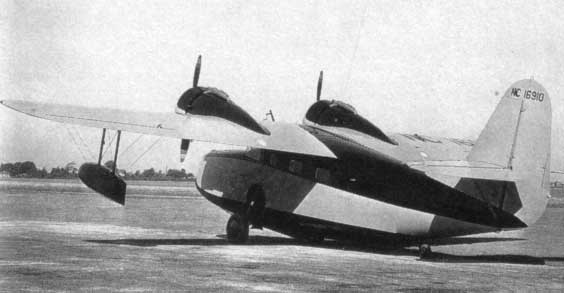 Grumman G-21 Goose parked-rear view. Note older style two bladed props. |
|
Grumman G-21 Goose on exhibit at Smithsonian. These days, they are mostly owned by wealthy sportsman pilots, or are operated by warbird enthusiasts; the few remaining have been relegated to museum status. |
|
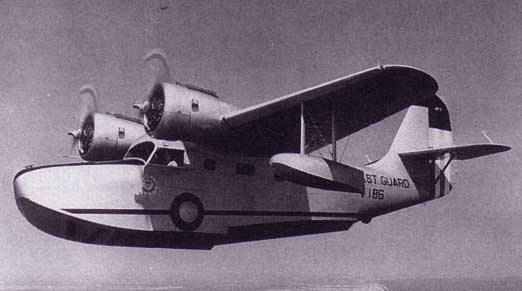 This is the Grumman G-21 Goose- Coast Guard version. The 'Goose' was perfectly suited for off-shore observation work |
|
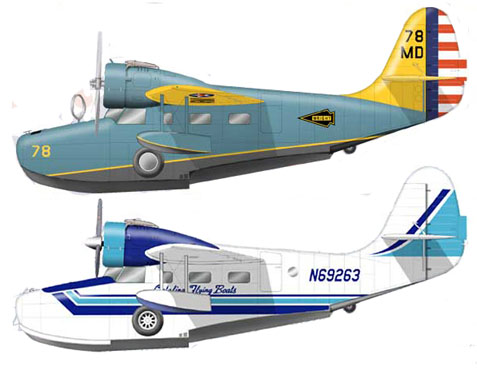 These THREE versions (above and below) are included in the Grumman Goose folder |
|
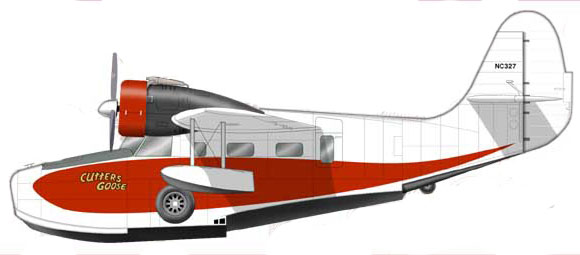 |
|
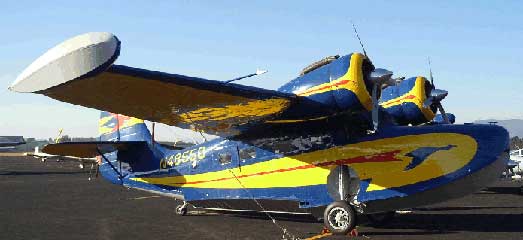 The State of Alaska and a few of the Alaskan airlines put the Goose to work on a daily basis for many years. |
|
Two Gooses (left) flying for the Catalina Airlines Inc. Perhaps those 4 white bags on the dock are mail. |
|
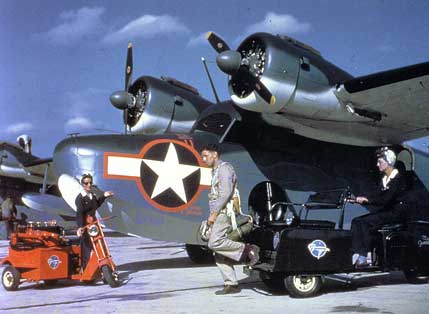 A very phony and posed photo of two Grumman Gooses at the factory |
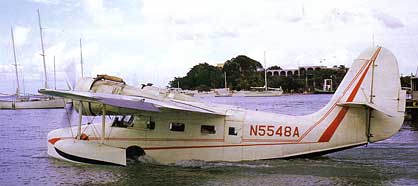 A Grumman Goose going out for some aviation This is my favorite Widgeon. When it was VH-WET in Australia in 1988 I rebuilt the rear fuselage and tailplane after it suffered an incident landing on a beach. Notice those lovely augmented 8 cylinder engines - flat 8 540 horsepower! How about someone doing a conversion? Marty |
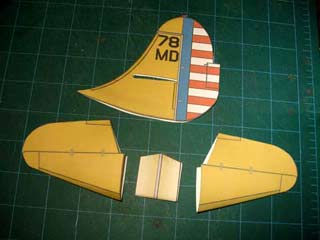 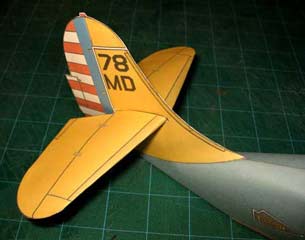 Modeln' Pal Joe Golden is preparing a tutorial of the Grumman Goose. These are the first bits |
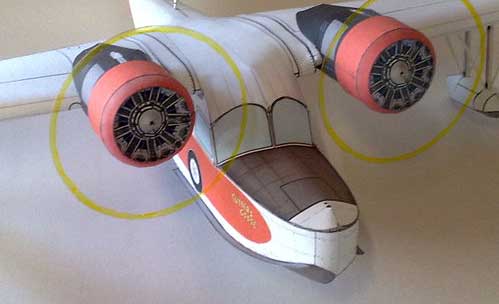 Two views of the Grumman Goose built by Niki Schutt |
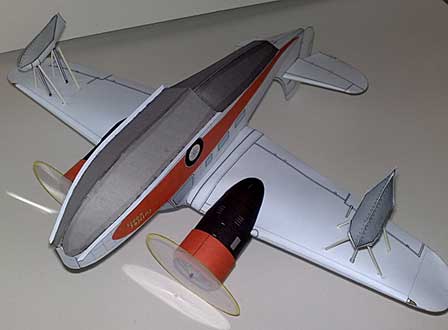 |
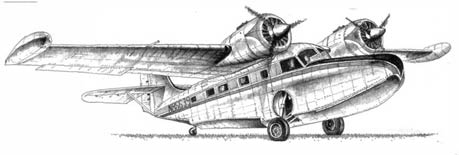
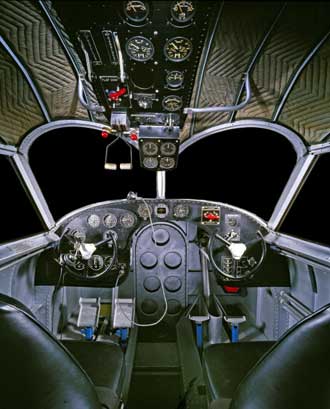 |
Grumman G-21 Goose Cockpit. |
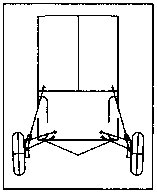 |
Grumman Goose Landing Gear Animation. |
Specifications for the JRF-5 Goose
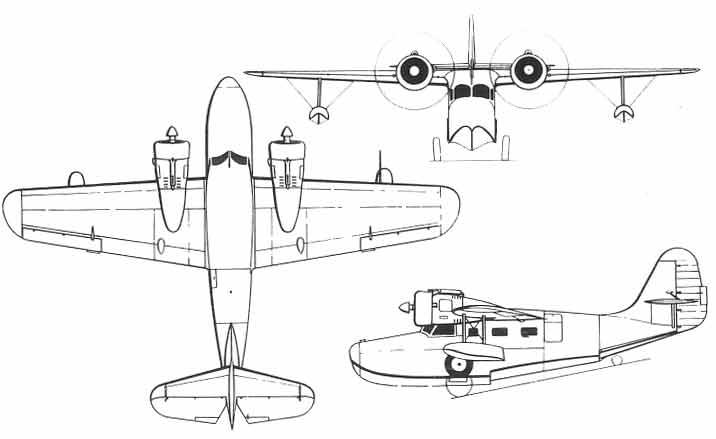 |
Crew: two–three |
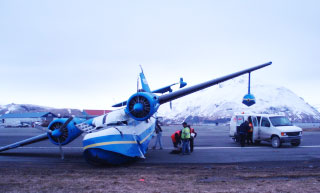 |
Nine people received minor injuries when a PenAir Grumman Goose collided with a truck during landing. |



